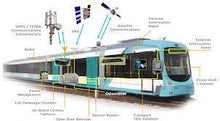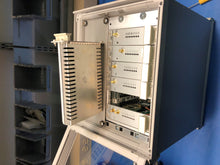Communications based Train Control CBTC
This product provides for safe passenger train operations by providing resources and systems to support the human operator. Most accidents are caused by human error, so these can be eliminated. The system has three components: the on-board system, the wayside units and the back office system. These are discussed below:
The On-board unit.
This system has a constant communications channel with the wayside stations which also has a wireless communications system. As the train moves along its route, the train radio connects to the nearest station and shares data. This data is used to guide the train when coupled with its own internally stored database. The on-board system has sensors for train speed, a GPS for train location and a dead-reckoning system. RFID tags along the rails at every mile or so are read and correct the trains on-board location system to correct for any error. The trains computer uses data from other trains to calculate position and possible conflicts in track assignments or speed differences. With separation known, the software moderates the speed of the train by lowering the speed display so the operator can reduce speed by his controls. If the operator fails to reduce the speed, the warning system will inform him and if still no reduction, the system will apply the brakes.
It is important to note that the system as described does not control the train. It is an advisory and emergency stop function where the operator still must control his train.
If complete driverless system is required, it is technically feasible but safety certification is rigorous and expensive. as well as creating labor union hassles.

The Wayside Interface Unit (WIU)
This is a radio system, and is ;located on a backbone communication network comprised of fiber optic or cellular radio. This WIU transfers data in both directions from the train and from Central Command. These WIU are usually located at each train stop for convenience.

The back office or Central Command
This system scans all wayside WIU and collects data from each train and saves that data in its real-time database system. It then sends all train data out to each respective train that needs it and in this way keeps each train informed of the train ahead. A map of the trains service area is provided to show the staff at the control station the real-time train location.
Alarms are given if the system loses communications with a train so the control center staff can respond with voice commands or stop trains in the area
Other subsystems:
Some CBTC systems control the sliding doors at the stations so passengers can unload/load. These are automated and driven when the train has properly stopped in the correct position at the station.
Features of Argenia's SafeNet CBTC
Speed enforcement eliminates over-speed accidents and derailments. Adjusts to different speed zones.
Collision Avoidance by maintaining safe separation based on the braking distance of the train at its current speed.
Reduced Headway- by knowing exact separation, the trains can run closer together and safer also.
Protection of track workers-the speed limits are input around work zones so train are forced to slow in work zones
Protection against switches in the wrong position- track switches are monitored so trains routes are allocated and cleared accordingly.
All of the needed features at half the cost of conventional suppliers. Call for a quotation and see.
Makes an ideal secondary detection system for operators that already have a system installed.








